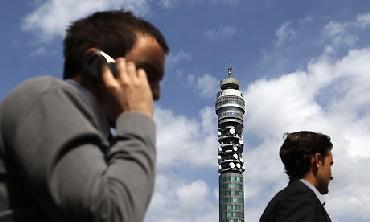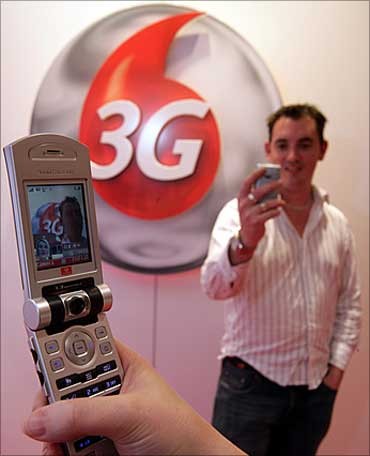 | « Back to article | Print this article |
Roti, kapda, makaan aur mobile
India is ranked third when it comes to minutes of mobile usage across the globe. The telecom sector alone directly contributes as much as $35 billion annually to the economy.
It is estimated to have offered employment to as many as 150,000 employees during the recession. The prosperity that the telecom sector has weaved into the Indian society is one of the main reasons for the growth of the middle income group, says this column.
India has always been a country known for its culture and tradition. Our culture inculcates in us the desire to remain closely connected and function as a cohesive unit. Little wonder, we are ranked third when it comes to minutes of mobile usage across the globe.
Click NEXT to read more...
Roti, kapda, makaan aur mobile
Telecommunications is a means to the end and has transformed the way of life for every Indian.
Considering that for every 10 per cent increase in mobile penetration rate, there would be a 0.6 per cent increase in GDP, telecommunications can be designated as a vital contributor to the economic growth of this country. The sector alone directly contributes as much as $35 billion annually to the economy.
The sector has helped create jobs in a country which has a high unemployment rate. The various functions including data entry, revenue accounting, human resource services, call centre operations, customer support centres and system support, and design helped generate gainful employment for a large set of Indians.
The sector is estimated to have offered employment to as many as 150,000 employees during the recession.
Click NEXT to read more...
Roti, kapda, makaan aur mobile
In fact, rural penetration has resulted in rural call centres catering to the smaller towns and villages in local languages. These rural BPOs have set a target of 1,000 centres and 150,000 employees by 2015.
The prosperity that the telecom sector has weaved into the Indian society is one of the pivotal reasons for the growth of the middle income group.
This group has obtained significance and their purchasing power has grown because they are able to reach out to the world at the touch of a button.
By 2015 this group will account for 60 per cent of the households in India as compared to 25 per cent in 2001.
Even remote parts of rural India, which were oblivious to the existence of wire line phones, began demanding the mobile phone to remain connected with the world at large.
Click NEXT to read more...
Roti, kapda, makaan aur mobile
The device became a necessity in every household where the breadwinner of the family was based in another town/city. Farmers had the option of buying mobiles from agriculture supply stores for their convenience.
The phone helped eliminate the middlemen which were intentionally feeding on the profits of the poor farmers. The mobile allowed farmers to keep up to date with the market prices for their produce on a real time basis.
You will find it hard to believe, but there are several farmers who access the BBC weather reports to remain updated about the weather forecasts.
The immense potential that this market holds lies in the fact that Indian villages account for 70 per cent of the country's total population, 56 per cent of the country's income, 64 per cent of consumption expenditure and 33 per cent of national savings.
Click NEXT to read more...
Roti, kapda, makaan aur mobile
The mobile device has also played an empowering role in controlling the spread of diseases by offering healthcare and allied services at the touch of a button.
It has helped combat epidemics such as HIV/AIDS and malaria by supplying information on treatment and control, generating awareness, improving access to and connectivity with health centres, and establishing the mobile testing of diseases.
In India, 54 per cent of the people have mobile phones compared to the 15 per cent banked population. Banks are looking at the mobile as a medium to penetrate the interior and remote areas of the country.
The world of m-commerce is likely to transform the way people bank and pay for goods and services. Operators and handset manufacturers are working together to build applications which will allow people to carry their wallets in their mobile phones.
The phone will act as a debit card, a credit card, a means for fund transfers and balance enquiry, all at the touch of a finger. This reality of one-touch banking has become a possibility only because of the mobile phone.
Click NEXT to read more...
Roti, kapda, makaan aur mobile
The world of 3G and BWA will help salvage the dismal state of broadband in this country. The wireless broadband will enable the larger part of the country to experience broadband for the first time on their mobile devices. In fact, increase in broadband penetration by 1 per cent will contribute Rs 162 billion, or 0.11 per cent, to Indian GDP in 2015.
Broadband penetration will enhance the uptake of e-governance at the micro-level across the country. The world of broadband will further open the world of knowledge and information that the mobile introduced in rural India.
This dissemination of knowledge is one of the key factors for gender equality for a woman, which has begun to gain significance in rural India.
From being demanded by a select few in the mid 90s, to becoming a commodity in 2010-11, the mobile phone itself has gone through a complete metamorphosis.
Click NEXT to read more...
Roti, kapda, makaan aur mobile
The earliest mobile device had the weight of a brick and primarily offered the function of calling and messaging. The mobile phone today has become the size of a credit card and packs in it a plethora of features that are being demanded by the end users.
Today almost every person, whether rich or poor, owns or intends to own a mobile phone. The mobile phone has lost its snob value and has emerged as a necessity in every household of India.
It is one of those things which erase the gap between the different sections of society. In a way, the mobile phone brings all the Indians on to a single platform, where the key demand of every user is to remain connected.
In 2003, when the new telecom policy was implemented, the mobile phone made it possible to remain connected to your near and dear ones at a cost of just Rs 2 per minute, followed by the SMS revolution. This growth was still limited to the elite, because of the high entry barrier.
Click NEXT to read more...
Roti, kapda, makaan aur mobile
The aggressive transformation was initiated with the launch of CDMA services, where the mobile operators began to offer a mobile phone along with a connection for a mere Rs 500.
This idea clicked with the masses and for the first time there was a waiting list to be awarded a mobile phone. A country of one billion plus people realised that this was the best way to keep everyone connected and before the close of that year, spotting every third individual with a mobile phone became a common sight.
The competitive tariffs in 2009 suddenly made the mobile phone seem like a device that was affordable for one and all. The operators began to introduce per-second billing so people could pay for only what they used.
Considering that 95 per cent of the subscriber base is prepaid, operators introduced small recharges in denomination of less than Rs 100. Data services were made available on all devices at a pocket-friendly cost.
Click NEXT to read more...
Roti, kapda, makaan aur mobile
The mobile has transformed the way people do business. The home delivery model has flourished because of the aggressive mobile uptake. Today we can order almost anything over the phone and have the same delivered to our doorstep.
The mobile phone has made its way into board rooms as projectors and conference call machines.
Executives across the country have one-touch access to mails on their phones, which has allowed them to remain in touch with work at all times and ensure greater commitment in the competitive corporate world.
The social networking bug which caught on with the youth became a key catalyst for operators and handset manufacturers to create devices which made it easy for them to remain connected with friends round the clock.
Click NEXT to read more...
Roti, kapda, makaan aur mobile
Entry of Indian branded handset segment further stirred the growth, by reaching out with feature-rich devices to the masses or the lower strata of society. Their aim was to create devices like those of the market leaders and make them available to the larger audience at a price which they could afford.
These devices and competitive tariffs played a complementary role in aggressively alleviating the demand for mobile phones across India.
Today, if you take a drive down the road, you will realise that no one is walking alone. Everyone is constantly communicating through the phone or in some cases has even learned to find a friend in this device itself.
The device has metamorphosed into an entertainment station which offers a multimedia camera, a music player, some mind-gripping games or round-the-clock access to social networking.
Click NEXT to read more...
Roti, kapda, makaan aur mobile
The world of 3G, which has recently been unveiled in this country, has made video calling a reality. Today every Indian family can buy a video calling phone for less than Rs 5,000 and talk to their near and dear ones on a real time basis.
Real time calling can help a country like India, where people across remote locations may not be able to access education and health services with ease. The world of video calling can act as a blessing in disguise for the people in these remote locations.
Mobile and computer are slowly and steadily merging to create a device which is handy and allows you to access everything at the touch of a finger.
These devices are becoming more and more intuitive and are likely to bring the world into your palm.
Click NEXT to read more...
Roti, kapda, makaan aur mobile
The mobile phone has played a wonderful role in helping a large part of India to progress towards globalisation.
Today people are aware of their surroundings, aware of the developments around them primarily because they are constantly communicating. In other words, the mobile can be characterised as a tool of convenience.
Communication and its media will evolve further. This device has in a way brought the entire world into the palm of every Indian.
The need of the common man was earlier limited to roti, kapda aur makaan. But, today the mantra is roti, kapda, makaan aur mobile.
I personally believe that this is by far one of the greatest inventions by mankind and the interesting part is that the best from this segment is yet to come.
The author is telecom industry leader, Ernst & Young. The views expressed are personal.











